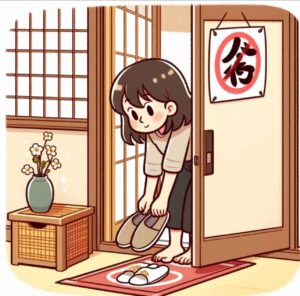
A Guide to Etiquette and Manners
Japanese etiquette is one of the most important reasons why Japanese people are so disciplined, and that makes them so splendid! Japan has a fantastic culture with unique beauty and charm that will catch your attention. However, it’s always a good idea to take the time to get to know Japan’s social customs and regulations before your trip to avoid any misunderstandings or unintentionally offending the locals. To make things easier for you, I have compiled a list of helpful tips that are categorized and will help you be a thoughtful foreigner during your stay in Japan.
Greeting and Bowing
Bowing is a customary and significant way of communicating in Japan. It is a way of demonstrating respect, appreciation, regret, or greeting to someone. The degree and length of the bow vary depending on the circumstance and the connection between the individuals. Typically, the deeper and longer the bow, the more polite it is. However, foreigners are not expected to be able to perfect the subtleties of bowing, and in most cases, a simple nod or slight bow of the head will suffice. You can also include verbal greetings, such as “Konnichiwa” (hello) or “arigato gozaimasu” (thank you very much), when bowing.
Here are some instances of when bowing is required:
- Greeting or saying goodbye to someone.
- Expressing gratitude for a favor, a present, or a service.
- Apologizing for an error, inconvenience, or trouble.
- Entering or leaving someone’s house, a temple, a shrine, or a shop.
- Presenting or receiving a business card.
Taking Off Shoes

One of the most common aspects of Japanese culture is removing shoes when entering certain establishments, such as homes, temples, traditional inns, or restaurants. This custom is rooted in the desire to maintain the cleanliness and comfort of indoor spaces and demonstrate respect for the host or location. Visitors will typically find a designated area near the entrance where they can remove their shoes and use the slippers provided by the host. It is essential to place one’s shoes neatly facing the door and refrain from wearing outdoor shoes inside or indoor slippers outside. Additionally, it is worth noting that different areas may require other slippers, such as bathroom or tatami slippers. Visitors should notice local cues or signs to switch their slippers accordingly.
Some examples of where to take off shoes are:
- Entering a house, especially if there is a raised floor or a tatami mat.
- Also, when entering a temple or a shrine, especially if there is a wooden floor or a carpet.
- In addition, when you enter a traditional inn or a ryokan, especially if there is a tatami room or a futon bed.
- Lastly, when entering some restaurants, especially if there is a tatami seating area or a low table.
Eating and Drinking

In Japan, specific manners and etiquette should be followed regarding eating and drinking. To begin with, it is essential to avoid sticking your chopsticks upright in your rice, as this is considered rude and is associated with funeral rituals. Avoid passing your food from chopstick to another chopstick as this is also taboo, as it has death connotations. It is also impolite to point or gesture with your chopsticks or use them to skew or stab your food. When not using your chopsticks, place them on the chopstick rest or the edge of your plate.
When drinking alcohol, it is customary to pour drinks for each other rather than for yourself. This is a way of showing hospitality and friendship. After everyone has poured their drinks, make a toast with “kanpai” (cheers) before drinking. It is also essential to keep your glass from becoming empty, as this implies that you want more. If you do not wish to drink, politely decline by leaving your glass full or covering it with your hand.
When eating at a restaurant, it is proper to say “itadakimasu” (I gratefully receive) before starting your meal and “gochiso sama deshita” (thank you for the meal) after finishing your meal. These phrases express your appreciation for the food and the service. You can also show your gratitude by complimenting the chef or staff with “oishii” (delicious) or “umai” (tasty).
In Japan, a tip is not expected or appreciated when paying the bill. Tipping is considered rude, implying inadequate service or the staff requiring charity. Instead, spend the exact amount or round up to 100 yen. When leaving, it is also polite to say “arigato gozaimasu” (thank you very much) or “gochisosamadeshita” to the staff.
Visiting Temples and Shrines

If you plan to visit Japan’s beautiful and sacred temples and shrines, following some etiquette and manners is essential to show respect for the religion and culture. Here are some guidelines that you should keep in mind:
- As you enter a temple or a shrine, you will typically find a purification fountain near the gate.
- It is advisable to wash your hands and mouth before proceeding to the main hall.
- You should use the spoon provided to scoop some water and rinse your left hand, then your right hand, then your mouth (spit the water into the drain, not the fountain), and then your left hand again.
- Put the spoon back in its original position, and do not touch the water directly with your mouth or hands.
- When you approach the main hall, you will see a large box or a rope with bells in front of the altar. It is where you can make a donation and pray.
- To make an offering, throw a coin into the box or pull the cord to ring the bell, bow twice, clap your hands twice, make a wish or a prayer, and then bow again.
- You should not take pictures, talk loudly in front of the altar, and do not touch or disturb any objects or decorations.
- As you walk around the temple or the shrine, it is crucial to be mindful of your surroundings and avoid stepping on the border stones or the sacred ropes that mark the boundaries of the holy space.
- It is also essential to refrain from touching or climbing on the statues, the lanterns, the torii gates, or other structures.
- Additionally, you should not eat or drink inside the temple or the shrine and do not bring pets or animals.
- It is best to be quiet and respectful and fully immerse yourself in the atmosphere and the architecture.
Public Transportation

Japan has a highly efficient and convenient public transportation system, encompassing trains, buses, subways, and taxis. However, observing proper etiquette and manners is crucial in ensuring a smooth and enjoyable ride for yourself and your fellow passengers. Here are some guidelines to follow:
- Queue up neatly and orderly behind marked lines or signs while waiting for a train or bus. Avoid pushing or cutting in line, and allow passengers to disembark before boarding. Listen to the staff instructions or announcements and refrain from blocking doors or aisles.
- Keep noise levels to a minimum when riding a train or bus to avoid disturbing other passengers. Please turn off or silence your mobile phone, avoiding its use for calls or music. Refrain from eating or drinking, and ensure no trash is left behind. Do not occupy more than one seat, and offer your heart to older people, pregnant women, people with disabilities, or children.
- It is not advisable to open or close taxi doors, as the driver will take care of it. Avoid smoking or eating inside the cab, and take extra caution to avoid damaging equipment. You can inform the driver of your destination by providing an address, landmark, or map. If necessary, request a receipt and pay the exact fare or round up your payment to 100 yen; tipping is not customary.
Shopping and Souvenirs

If you shop in Japan, you should adhere to several customs and protocols. Japan offers a variety of shopping options, from traditional markets and crafts to modern malls and electronics. You can find numerous unique and high-quality products that make excellent souvenirs for yourself, friends, and family. However, there are certain etiquette and manners that you should follow when shopping in Japan. Here are some guidelines to keep in mind:
- Upon entering a shop, you will usually be greeted by the staff with a warm “irasshaimase” (welcome) or “konnichiwa” (hello). You can respond with a smile or a nod or ignore it if you are uninterested. Do not feel obliged to purchase anything, nor attempt to bargain or haggle, since the prices are typically fixed.
- When browsing or buying a product, avoid touching or handling it roughly, as this can damage or soil it. If you want to try or test something, ask for permission from the staff. Taking pictures or videos without authorization may infringe upon the shop’s or product’s privacy or intellectual property rights.
- You typically see a small tray or basket on the counter when paying for a product. This is where you should place your money or card rather than handing it directly to the staff. It is done to avoid any physical contact or confusion. You will receive your change and receipt on the tray or basket. When leaving, you can also express your gratitude to the staff by saying “arigato gozaimasu” (thank you very much).
Garbage Disposal

Japan is a spotless and tidy country, and the people take pride in keeping their environment and public spaces neat and orderly. However, Japan also has a strict and complex garbage disposal system, which requires careful sorting and separation of different types of waste. Some tips on how to dispose of your garbage correctly in Japan are as follows;
- When staying at a hotel, an apartment, or a house, you will usually find separate bins or bags for different kinds of garbage, such as burnable, non-burnable, recyclable, or plastic. Follow the instructions or the labels on the containers or backpacks, and do not mix or contaminate the garbage. If you need more time, ask the staff or the host for help.
- You will notice only a few public trash cans or bins on the streets or parks when going out. This is because Japanese people usually carry their garbage with them until they find a proper place to dispose of it, such as a convenience store, a train station, or a vending machine. Do not litter or leave your garbage behind. Also, do not use the wrong bin or bag for your trash.
- When visiting a convenience store, a supermarket, or a department store, you will often receive a plastic bag for your purchases. However, you can also bring your reusable bag or decline the plastic bag if you do not need it. It is to reduce the amount of plastic waste and to protect the environment. You can also return the plastic bottles or cans you bought from the store to the designated machines or bins and receive a small refund or a coupon.
Gift Giving and Receiving

In Japan, gift-giving and receiving are customary practices with significant cultural value, especially on special occasions like weddings, birthdays, holidays, and visits. Gifts are a way of expressing appreciation, respect, friendship, or apology to someone. However, certain etiquette and manners should be followed when giving or receiving gifts in Japan. Some essential guidelines are as follows:
- Avoid expensive, personal, or controversial gifts. Instead, opt for local specialties, souvenirs, sweets, fruits, flowers, or stationery. Scissors, knives, clocks, potted plants, or white flowers should be avoided as they carry negative or unlucky connotations in Japan.
- Use colorful and cheerful wrapping paper or cloth, and avoid plain or dark colors like black, white, or blue. Ribbons, stickers, or cards can be used to decorate the gift. Avoid recycling or reusing paper or cloth as it may convey a lack of regard for the recipient.
- When giving or receiving a gift, use both hands to offer or accept it on a table or tray. It is considered impolite to hand it over directly. Open the facility only if the giver insists or requests you—this avoids embarrassment or disappointment if the gift is not suitable or satisfactory. To show modesty and humility, you can say “tsumaranai mono desu ga” (this is a trivial thing, but) when giving a gift or “osore irimasu” (I am unworthy) when receiving a gift.
These are some of the essential etiquette and manners to remember in Japan. While there are many other details and variations to be aware of, following these tips will ensure a respectful and enjoyable experience in this beautiful and fascinating country.
Do you know any other Japanese etiquette and manners that we should know as foreigners living and working in Japan? Let me know in the comment below. Thanks for reading, and I’ll see you at the next one!



